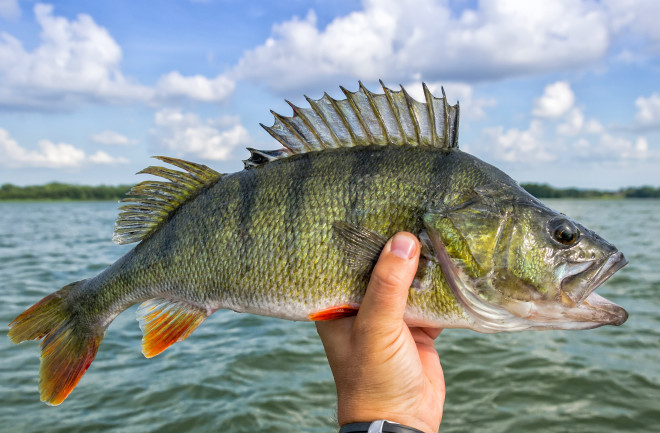Fishing is a hallmark of U.S. outdoor culture. Within the country, some 41 million people fished in freshwaters in 2021, including both recreational fishers and those who rely on their catch to supplement their diet. But troubling news broke in spring 2023 when researchers disclosed the surprising reach of dangerous chemicals in U.S. lakes and streams.
What are the PFAS Levels in Fish?
Freshwater fish, it turns out, pack a heavy dose of PFAS (per- and polyfluoroalkyl substances), a body of synthetic chemicals that generally don’t break down in nature — or in our bodies. A study published in March in Environmental Research offered a sobering analysis of how the fish we eat in the U.S. affect PFAS levels in the human bloodstream.
The researchers found that freshwater fish contain levels 278 times higher than those that are farm-raised or marine-caught and sold at grocery stores. Eating a single freshwater fish a year could expose a person to the same PFOS levels (a type of PFAS) as drinking highly polluted water for a month. Currently, no federal regulations or recommendations exist regarding fish consumption and PFAS risk.
“Even a couple meals a year can considerably increase the amount [of PFAS] in your blood,” says study co-author Tasha Stoiber, senior scientist at the research- and advocacy-focused Environmental Working Group. “What we’re finding here is that [fish] could be a significant source.”
Where does PFAS Pollution Come From?
The chemicals — which create an incredibly strong carbon and fluorine bond — have historically been used in firefighting foams, water-resistant products, and Teflon nonstick pans. Nowadays, PFAS is seemingly everywhere, spanning more than 12,000 types of chemicals, most of which we can’t easily detect. It’s often present in clothes, food wrapping, dental floss, and tap water across the country.
The chemicals have been associated with health impacts that range from reduced immunity and metabolism to testicular and kidney cancer. Some PFAS chemicals do slowly leave our bodies — through urine, menstrual blood, and breast milk. Yet researchers remain uncertain about the largest common sources of exposure, says Laurel Schaider, a senior scientist at the independent research organization Silent Spring Institute, which focuses on links between everyday chemicals and women’s health. “It depends on what you eat and what exact products you have in your home,” she says.
Who Does PFAS Impact?
The new freshwater fish research identified an elevated risk for low-income and non-white populations across the U.S. That’s because experts know that people of color and those who are older, low-income, Indigenous, or born outside the U.S. are more likely to practice subsistence fishing to feed their households, making them more vulnerable.
The study found some of the highest levels of PFOS in fish in the Great Lakes, whose commercial fishing industry — valued at over $19 million in 2015 — provides fish throughout the Upper Midwest and Canada. That means the impact could hit anyone who enjoys a local fish fry, as well as growing refugee populations, such as the Burmese. Many of these relocated families have continued fishing traditions on the Great Lakes — either as a hobby, a job, or as a food source.
A 2022 study found that Burmese participants living near Onondaga Lake in New York had elevated blood levels of PFAS compared to the general U.S. population. “People do deserve to know if the food that you’re eating could be a significant source of [PFAS] exposure to your body,” Stoiber says.
After immigrating to the U.S. eight years ago, Mohamed Anwar co-founded the Burmese Rohingya Community of Wisconsin, a grassroots organization that provides education and health programs to resettled Rohingya refugees. He also works as a translator in a hospital, but even he had never heard of PFAS as of last spring. It’s likely many in his community haven’t either.
Policy and PFAS
The new paper closes at least one information gap that could help regulators and health officials issue guidance to shield the public from unnecessary PFAS exposure. Diet is likely to be “an important driver of exposure,” Schaider says, given the ways plants and animals can absorb chemicals from their environments.
But another concerning study surfaced in July from the U.S. Geological Survey. That work estimated that nearly half of all U.S. tap water is contaminated with one or more PFAS chemicals, elevating the urgency of questions about human exposure. The research emerged just a few months after the Environmental Protection Agency proposed first-of-their-kind regulations on PFAS in drinking water, which should be finalized by 2024.
The effort would establish maximum contaminant levels for multiple PFAS compounds and require monitoring by public water systems. If implemented, the new regulations could prevent thousands of deaths and reduce tens of thousands of PFAS-related illnesses.
This story was originally published in our January February 2024 issue. Click here to subscribe to read more stories like this one.

